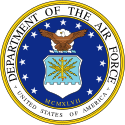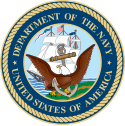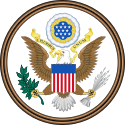Verteidigungsministerium der Vereinigten Staaten
| United States Department of Defense — US DoD — | |
|---|---|
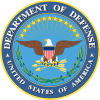 | |
| Staatliche Ebene | Bundesebene |
| Stellung der Behörde | Bundesministerium |
| Aufsichtsbehörde(n) | Regierung der Vereinigten Staaten |
| Bestehen | seit 26. Juli 1947 |
| Entstanden aus | United States Department of War und United States Department of the Navy |
| Hauptsitz | Arlington County, Virginia (Pentagon) |
| Haushalt | 738 Mrd. $[1] (2020) |
| Verteidigungsminister („DefSec“) | Pete Hegseth |
| Mitarbeiter | 700.000 (ziv.), 1.418.542 (mil.) |
| Website | www.defense.gov |
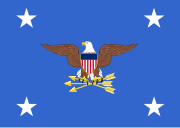
Das Verteidigungsministerium der Vereinigten Staaten (englisch United States Department of Defense, abgekürzt US DoD oder DoD) wurde mit der Verabschiedung des National Security Act durch den US-Präsidenten Harry S. Truman am 26. Juli 1947 zunächst als National Military Establishment ins Leben gerufen und 1949 in United States Department of Defense umbenannt. Das Verteidigungsministerium hat seinen Sitz im Pentagon.
Das Verteidigungsministerium wurde 1947 aus bis dahin selbständigen Ministerien und Einheiten der Streitkräfte gebildet. In ihm wurden dann die ursprünglich eigenständigen Ministerien mit Kabinettsrang für die Landstreitkräfte (United States Department of War) und die Seestreitkräfte (United States Department of the Navy) zu einem gemeinsamen Ministerium zusammengefasst.
Auftrag
Das DoD ist zuständig für sämtliche Belange der Landesverteidigung. In dieser Funktion ist es verantwortlich für die militärische und finanzielle Planung sowie für die Ausbildung, Ausrüstung, Bereitstellung und Führung der US-Streitkräfte.
Der Verteidigungsminister bildet gemeinsam mit dem Präsidenten als Oberbefehlshaber der Streitkräfte die National Command Authority (NCA), die im Bedarfsfall die Entscheidung über den Einsatz von Kernwaffen fällt.
Organisation

Streitkräfteämter
Das Department of Defense hat für die einzelnen Teilstreitkräfte einzelne Staatssekretäre mit nachgeordneten Fachabteilungen (Departments). Für die US Navy und das US Marine Corps ist das United States Department of the Navy zuständig, für die US Air Force und die US Space Force das United States Department of the Air Force und für die US Army schließlich das United States Department of the Army. Die Küstenwache untersteht in Friedenszeiten nicht dem Verteidigungsministerium, sondern dem Ministerium für innere Sicherheit. Im Kriegsfall kann sie jedoch dem Department of the Navy unterstellt werden.
Behörden

Hinzu kommen diverse subalterne Behörden, die dem DoD unterstehen:[2]
- Business Transformation Agency (BTA)
- Defense Advanced Research Projects Agency (DARPA)
- Defense Commissary Agency (DECA)
- Defense Contract Audit Agency (DCAA)
- Defense Contract Management Agency (DCMA)
- Defense Finance and Accounting Service (DFAS)
- Defense Information Systems Agency (DISA)
- Defense Intelligence Agency (DIA)
- Defense Legal Services Agency (DLSA)
- Defense Logistics Agency (DLA)
- Defense Security Cooperation Agency (DSCA)
- Defense Security Service (DSS)
- Defense Threat Reduction Agency (DTRA)
- Missile Defense Agency (MDA)
- National Geospatial-Intelligence Agency (NGA)
- National Security Agency (NSA)
- Pentagon Force Protection Agency (PFPA)
Budget
Ausgaben
Unter dem US-Präsidenten George W. Bush wurde der jährliche Verteidigungsetat der USA permanent angehoben, und auch unter dem Präsidenten Barack Obama stiegen die Ausgaben in seinen ersten zwei Amtsjahren. Erst durch das Ende des Irak-Krieges (2011) sowie die Beendigung der Operation Enduring Freedom in Afghanistan zum Jahresbeginn 2015, nur gefolgt von einem relativ kleinen Engagement in der Operation Resolute Support, wurden Kapazitäten frei, die es ermöglichten, das Budget ab 2012 zu senken – auch wegen der Weltwirtschaftskrise, welche die USA hart getroffen hat.
Das Budget des Haushaltsjahres 2020 belief sich auf 738 Milliarden US-Dollar.[3] Damit ist dieses Budget das drittgrößte in den USA nach dem Budget des Gesundheitsministeriums sowie den Ausgaben für die Sozialversicherung und Sozialhilfe. Nach Mitarbeitern ist das Verteidigungsministerium sogar das größte in den USA, mit etwa zwölfmal so vielen Mitarbeitern wie das Kriegsveteranenministerium, dem nach Mitarbeitern zweitgrößten Ministerium.
Benennung
Zu beachten sind die unterschiedlichen Betrachtungsweisen des Budgets. Der Begriff military budget schließt auch die Ausgaben für die nationalen Atomwaffen des Department of Energy mit ein. Das reine Streitkräftebudget heißt defense budget.
Kritik
Bereits seit Jahren kritisieren Offiziere, Analysten und Politiker die Budgetierung des US-Militärs. Sie beklagen, dass die Verstärkung des militärischen Apparates bei aller modernen Strukturierung, Ausbildung und Ausrüstung immer noch nur in den Kategorien des Kalten Krieges stattfindet. Daher fordern sie je nach Zugehörigkeit eine zurückhaltendere Außenpolitik mit entsprechend reduzierten Standorten oder Einsätzen, einen effizienteren Einsatz der Steuermittel oder aber ein revolutionäres Umdenken in der militärischen Planung. Diese soll mehr Vertrauen in die Verbündeten und eine bessere Fixierung auf die Bedrohungen des 21. Jahrhunderts beinhalten. So soll zum Beispiel der Verzicht auf militärische Statussymbole wie Kampfpanzer oder die F-22 die Kosten ebenfalls stark senken können.[4]
In den 1980er-Jahren verfasste der zivile Pentagon-Mitarbeiter Franklin C. Spinney einen dienstlichen Bericht über finanzielle Verschwendung.[5] Franklin Spinney wurde vorgeladen, um am 4. März 1983 vor dem US-Senat auszusagen. Am 7. März 1983 erschien er auf der Titelseite des Time Magazine.
Am 10. September 2001 gab Verteidigungsminister Donald Rumsfeld bekannt, dass sein Ministerium Transaktionen im Wert von etwa 2300 Milliarden Dollar nicht erklären kann.[6] Im Jahr 2016 war der Betrag auf 6500 Milliarden gestiegen, alleine für die Teilstreitkraft Heer.[7] Im November 2022 wurde bekannt, dass das Verteidigungsministerium zum fünften Mal in einer Reihe die gesetzlich erforderliche jährliche Rechnungsprüfung nicht bestanden hatte.[8]
Siehe auch
- Liste der Verteidigungsminister der Vereinigten Staaten
- National Defense Authorization Act
- Senior Military Assistant to the Secretary of Defense
- United States Deputy Secretary of Defense
Literatur
- Douglas Kinnard: The Secretary of Defense. University Press of Kentucky, Lexington 1980, ISBN 0-8131-1434-9.
- Michael T. Klare: All Hell Breaking Loose. The Pentagon's Perspective on Climate Change. Metropolitan Books, New York City 2019, ISBN 978-1-627792486.
Weblinks
- Website des Verteidigungsministeriums (englisch)
- Tabellarische Auflistung des jährlichen Verteidigungshaushalts, 1946–2009 (englisch)
- Wörterbuch militärischer Begriffe des Verteidigungsministeriums (englisch)
- Direktivsammlung des Verteidigungsministeriums
Einzelnachweise
- ↑ Trump Signs Law Establishing U.S. Space Force. In: defense.gov. 20. Dezember 2019, abgerufen am 13. Februar 2020 (englisch).
- ↑ United States Department of Defense: DOD Websites (englisch), abgerufen am 27. Februar 2017.
- ↑ Trump Signs Law Establishing U.S. Space Force. In: defense.gov. 20. Dezember 2019, abgerufen am 13. Februar 2020 (englisch).
- ↑ Newt Gingrich: A leaner, meaner military. In: The Washington Post. 4. März 2006 (englisch washingtonpost.com). Abgerufen am 2. Januar 2011.
- ↑ Franklin C. Spinney: Defense facts of life: the plans/reality mismatch. Westview Press, 1985.
- ↑ Business practices at the Pentagon. C-SPAN, 10. September 2001.
- ↑ Laurence Kotlikoff: Has our government spent $21 trillion of our money without telling us? Forbes, 8. Dezember 2017.
- ↑ Connor Echols: The Pentagon fails its fifth audit in a row. Responsible Statecraft, 22. November 2022.
Auf dieser Seite verwendete Medien
Organizations and Functions of the Department of Defense
U.S. Department of The Army Emblem.
- In the center is a Roman cuirass below a vertical unsheathed sword, point up, the pommel resting on the neck opening of the cuirass and a Phrygian cap supported on the sword point, all between on the right an esponton and on the left a musket with fixed bayonet crossed in saltire behind the cuirass and passing under the sword guard.
- To the right of the cuirass and esponton is a flag of unidentified designs with cords and tassels, on a flagstaff with spearhead, above a cannon barrel, the muzzle end slanting upward behind the cuirass, in front of the drum, with two drumsticks and the fly end of the flag draped over the drumhead; below, but partly in front of the cannon barrel, is a pile of three cannon balls.
- To the left of the cuirass and musket is a national color of the Revolutionary War period, with cords and tassels, on a flagstaff with spearhead, similarly arranged above a mortar on a carriage, the mortar facing inward and in front of the lower portion of the color and obscuring the lower part of it; below the mortar are two bomb shells placed side by side.
- Centered above the Phrygian cap is a rattlesnake holding in its mouth a scroll inscribed "This We'll Defend."
- Centered below the cuirass are the Roman numerals "MDCCLXXVIII."
- For differences between this text description and the emblem shown above, see "Army Seal vs. Army Emblem", below.
Seal of United States Department of the Air Force - military department for the United States Air Force and the United States Space Force
Seal of the United States Marine Corps. It is defined in Executive Order 10538 (alternate source) as:
For more information, see here.Standing upon the western hemisphere of the terrestrial globe containing the lines of latitude and topographical outlines of North, Central, and South America, an American bald eagle with wings displayed horizontally and inverted holding in his beak a scroll inscribed with the motto SEMPER FIDELIS, all bronze. Behind the western hemisphere a foul anchor bend sinister-wise with stock, arms, and flukes in slight perspective, all bronze, on a scarlet background and within a dark blue band edged in gold circumscribed by a gold rope rim and inscribed DEPARTMENT OF THE NAVY • UNITED STATES MARINE CORPS in gold letters. The central device of the seal is the emblem of the United States Marine Corps.
Seal of the United States Department of Homeland Security. A graphically styled American eagle appears in a circular blue field. The eagle's outstretched wings break through an inner red ring into an outer white ring that contains a circular placement of the words "U.S. DEPARTMENT OF" in the top half and "HOMELAND SECURITY" in the bottom half. The outer white ring has a silvery gray border. As in The Great Seal, the eagle’s left claw holds an olive branch with 13 leaves and 13 seeds while the right claw grasps 13 arrows. Centered on the eagle's breast is a shield divided into three sections containing elements that represent the homeland "from sea to shining sea." The top element, a dark blue sky, contains 22 stars representing the original 22 agencies and bureaus that have come together to form the department. The left shield element contains white mountains behind a green plain underneath a light blue sky. The right shield element contains four wave shapes representing the oceans, lakes and waterways alternating light and dark blue separated by white lines.
United States Coast Guard Seal, in correct PMS colors. This emblem shall only be used in accordance with the Coast Guard Heraldry Manual, and is not to be reproduced commercially without prior approval of the U.S. Coast Guard.
The personal flag of the United States Secretary of Defense.
*Description: On a circular background of fair sky and moderate sea with land in sinister base, a tri-mast square rigged ship under way before a fair breeze with after top-sail furled, commission pennant atop the foremast, National Ensign atop the main, and the commodore's flag atop the mizzen. In front of the ship a luce-type anchor inclined slightly bendwise with the crown resting on the land and, in front of the shank and in back of the dexter fluke, an American bald eagle rising to sinister regarding to dexter, one foot on the ground, the other resting on the anchor near the shank; all in proper colors. The whole within a blue annulet bearing the inscription "Department of the Navy" at the top and "United States of America" at the bottom, separated on each side by a mullet and within a rim in the form of a rope; inscription, rope, mullet, and edges of annulet all gold. *Background: The policy for use of the Navy seal and emblem is contained in SECNAV Instr 5030.4 and SECNAV Instr 5030.6. The seal design was approved by the President of the United States by Executive Order 10736 dated October 23, 1957. Request for use of the Navy emblem should be submitted in writing to Defense Printing Service, ATTN: DPSMO, 8725 John Kingman Rd Suite 3239, Fort Belvoir, VA 22060-6220. The telephone number is (703) 767-4218. 1879 version here: http://etc.usf.edu/clipart/54900/54985/54985_seal_navy.htm
Das de:Pentagon; Sicht nach Nordosten mit dem Potomac River und Washington Monument im Hintergrund
Seal of the United States Space Force.
Seal of the United States Department of Defense from 2001 to 2022.




